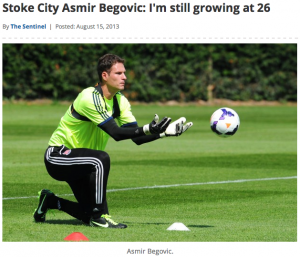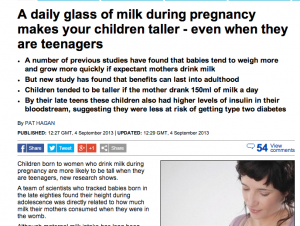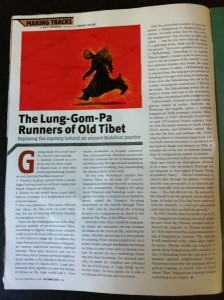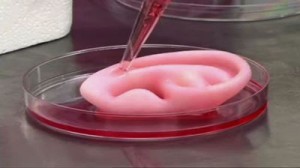Why Would Parents Purposely Stunt Their Daughter’s Growth?
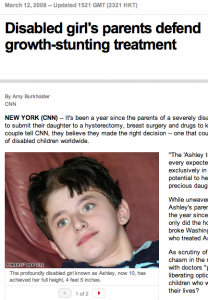 I found this most unique of stories recently from the CNN website. It seems that parents of a girl who had been born brain dead purposely chose to use chemical treatment to stunt their daughter’s growth. It turns out that the story had been a very old story, from back in March of 2008 entitled “Disabled girl’s parents defend growth-stunting treatment“ on CNN.
I found this most unique of stories recently from the CNN website. It seems that parents of a girl who had been born brain dead purposely chose to use chemical treatment to stunt their daughter’s growth. It turns out that the story had been a very old story, from back in March of 2008 entitled “Disabled girl’s parents defend growth-stunting treatment“ on CNN.
I took the liberty of copying and pasting the whole story below. At this point, I’ve fully realized that often old links and old stories often disappear so most articles or studies will be referenced or posted to this website for safe keeping.
NEW YORK (CNN) — It’s been a year since the parents of a severely disabled child made public their decision to submit their daughter to a hysterectomy, breast surgery and drugs to keep the girl forever small. Today, the couple tell CNN, they believe they made the right decision — one that could have a profound impact on the care of disabled children worldwide.
The profoundly disabled girl known as Ashley, now 10, has achieved her full height, 4 feet 5 inches.
“The ‘Ashley treatment’ has been successful in every expected way,” Ashley’s parents told CNN exclusively in a lengthy e-mail interview. “It has potential to help many others like it helped our precious daughter.”
While unwavering in their belief in the treatment, Ashley’s parents continue to insist on anonymity. In the year since Ashley’s parents went public, not only did the hospital that sterilized Ashley admit it broke Washington state law, but also the doctor who treated Ashley committed suicide.
As scrutiny of the case deepens, so too does the chasm in the medical community: Is it mutilation, with doctors “playing God” — or, is stunting growth a liberating option for caregivers and the disabled children who will need constant care for the rest of their lives?
Ashley is now 10 years old and, at 4 feet 5 inches tall, has achieved her full height and weight, 63 pounds. The treatment permanently closed her growth plates and took more than a foot off her anticipated height.
“Ashley did not grow in height or weight in the last year, she will always be flat-chested, and she will never suffer any menstrual pain, cramps or bleeding,” say her parents, who felt it important to publicly address their decision after repeated interview requests, in the hopes of sharing their experience with other families.
They responded by e-mail only, to protect the family’s identity. (Read the complete interview)
Ashley’s current state — to them — is the definition of success.
She was born brain-damaged, with a condition described as static encephalopathy, or cerebral palsy. One of her doctors described her mental capacity as that of a 6-month-old, dependent upon her parents to meet every need. She does not walk or talk; she’s fed through a tube and wears diapers. When Ashley was 6, her parents approached Children’s Hospital and Regional Medical Center in Seattle, Washington, for the operations. They believed this would make it easier to cuddle and carry a child who can do little more than lie propped on a pillow.
Weight and height are the “worst enemy,” they write, for children such as Ashley, for whom they’ve coined the term “pillow angels.”
In 2004, Children’s Hospital performed a hysterectomy, removed Ashley’s breast buds and gave her high-dose estrogen to retard growth and sexual maturation — a procedure that has risks, but to date has not harmed her, her parents say.
While the “Ashley treatment” was first published in the October 2006 issue of the Archives of Pediatrics & Adolescent Medicine, it wasn’t until the family posted its blog last year that a firestorm erupted in the blogosphere, with responses from “inhumane” and “perverse” — to “walk in our shoes.”
“If parents of children like Ashley believe this treatment will improve their children’s quality of life, then they should be diligent and tenacious in providing it for them,” her parents write. “We have a sacred duty to do what we believe is right for our children.”
But in Ashley’s case, what her parents thought was right wasn’t legal.
In May 2007, Children’s Hospital admitted it broke state law by giving Ashley a hysterectomy without a proper court review. To perform any such treatment today would require a court order, as well as review by a panel of experts in medicine and ethics and people with disabilities, says Dr. Douglas Diekema of Treuman Katz Center for Pediatric Bioethics, the consulting ethicist on Ashley’s case.
So, will doctors stop the growth of more children like Ashley?
Right now, no growth-attenuation therapy is being administered by other doctors anywhere in the nation, according to pediatric experts. Supporters wonder whether another factor, the suicide in September of Ashley’s endocrinologist, Dr. Daniel Gunther, may have slowed wider adoption of the treatment.
“We know from reliable sources his treatment of our daughter was a source of energy and motivation for him,” Ashley’s parents write. “He was frustrated about being blocked from providing this treatment to other children in need. He strongly believed this treatment should be available to them.”
The family appears to be the lone voice with that opinion; CNN shared the family’s comment with Children’s Hospital, but did not get a response. In media reports, colleagues and family members were said to believe Gunther’s suicide was not related to the treatment of the girl.
Another complicating factor — some doctors remain adamant the treatment shouldn’t be available.
“Adults can consent. But for a child, we’re making decisions for them and hoping in our heart of hearts we are making the right decisions,” says Dr. Nancy Murphy, chairman of the American Academy of Pediatrics Committee on Children with Disabilities.
Murphy will push for consensus among doctors at a pediatrics conference later this year, but acknowledges strong discord as critics continue to insist that keeping children small reduces them to a permanent infant-like condition, denying the basic human right to experience an adult body, adult feelings and adult relationships. But for Ashley, that may be moot.
“[This disability] shatters the reason we become parents: to watch kids grow, to be part of their lives and to launch into their own lives,” says Murphy. “When you have a child with lifelong dependency, you don’t get to launch your kid, and your caregiver options are limited.”
But like many other people with disabilities, 43-year-old Anne Rader, who also has cerebral palsy but in a much less severe form than Ashley’s, sees the treatment as dehumanizing — and perhaps most significantly — irrevocable.
“The parents are not seeing the potential of the child; they are seeing a baby,” says Rader. “People with disabilities have to look at the potential of our lives: of available new technology, new equipment, medical advances. Things can change so quickly now.”
Some ethicists, too, remain staunch in their assessment that the “Ashley treatment” is a violation of not only human dignity, but also of a physician’s oath to do no harm.
“I think mutilating surgery involving removal of breast buds is indefensible under any circumstances,” says Arthur Caplan, the chairman of the Department of Medical Ethics and director of the Center for Bioethics at the University of Pennsylvania. “Growth retardation is not a substitute for adequate home aides and home assistance.”
Ashley’s parents remain convinced what they did for Ashley is the most loving choice they could have made for their daughter and want that for other disabled children.
“We feel that if our time and effort ended up helping a single pillow angel… then it is worthwhile.”
———————————
(CNN) — The parents of “Ashley,” who underwent a controversial therapy to stop her from growing, agreed to speak exclusively to CNN about their daughter’s health, the controversy the therapy has engendered among disability advocates, the suicide of the doctor who pioneered the procedure and the future of more children like Ashley.
Ashley remains completely dependent, her parents say. She can’t talk or walk and is fed through a tube.
While her parents asked to remain anonymous to protect the family, they did answer CNN’s questions about Ashley via e-mail.
CNN: In photos from 2007, Ashley looks happy and engaged. What prompts her to smile?
Ashley’s parents: Ashley enjoys our company and our voices; when we sweet talk to her she often radiates with a big smile. She enjoys rich music, walks outdoors, a swim on a warm day, the swing, etc.
She is also very fragile; a sneeze can set her crying inconsolably for more than an hour.
CNN: You say Ashley is profoundly dependent on you. How so?
Ashley’s parents: Ashley is now and will always be dependent on us in every aspect of her life: On an hourly basis we give her a position change and prop her back on her pillow; we make sure she is well covered and pull her shirt down to cover her tummy; we wipe her drool, etc. Also there are diaper changes, tube feedings, dressing, bathing, teeth cleaning, stretching, entertainment, etc.
CNN: Has anything changed?
Ashley’s parents: Ashley’s tolerance and ability to sleep at night have improved considerably.
CNN: Does Ashley have interaction with children outside of your family — does she have peers?
Ashley’s parents: Given Ashley’s limited cognitive abilities, there’s not much interaction.
CNN: Has Ashley’s outcome been what you expected?
Ashley’s parents: Thankfully, the “Ashley treatment” went smoothly, and it has been successful in every expected way. Her recovery from surgery was quick and uneventful, the scars are barely visible. There have been no side effects to the estrogen therapy. Ashley did not grow in height or weight in the last year, she will always be flat-chested, and she will never suffer any menstrual pain, cramps, or bleeding!
CNN: What was your response to [Ashley’s endocrinologist Dr. Daniel] Gunther’s death last fall? People will inevitably ask, do you think your controversial case was a source of conflict or personal turmoil for Gunther?
Ashley’s parents: We were shocked and saddened for his loss and feel deeply sorry for his family. He was a kind, dedicated and principled person, whom we and many other families whom he helped have a lot of admiration for.
We know from reliable sources that his treatment of our daughter was a source of energy and motivation for him. We also know from conversations with him that he was frustrated about being blocked from providing this treatment to other children in need. He empathized with parents and with their children and he strongly believed this treatment should be available to them.
CNN: What do you consider Gunther’s legacy to be?
Ashley’s parents: From e-mails we received, there are many “Ashleys” out there, who form a new category of disability that we affectionately call pillow angels (see our one slide summary). We estimate that under 1 percent of children with disabilities are in this category. Outside a small community of parents and caregivers who have the direct experience of caring for pillow angels, society does not know much about them and their special needs. Based on the hundreds of e-mails and testimonies we’ve received from this small community, it is abundantly obvious that increased weight and height are the worst enemy for pillow angels.
Dr. Gunther’s legacy is that he had the knowledge, compassion, confidence and courage to be the first to administer this estrogen therapy to a pillow angel, which sped up the natural closure of her growth plates and kept her small. Given the overwhelming supportive reaction that we have seen from parents and caregivers of pillow angels, we strongly believe that this therapy should be an option for the rare kids like Ashley, and Dr. Gunther has secured a place in history as its pioneer.
CNN: Your advice to others contemplating this procedure for their profoundly disabled children?
Ashley’s parents: As parents we have a sacred duty to do what we believe is right for our children. If parents of children like Ashley believe that this treatment will improve their children’s quality of life, then they should be diligent and tenacious in providing it for them.
CNN: Do you consider yourselves a voice for any group? Do you consider yourselves foes of any group?
No and no. We’re simply passionate about sharing our experience and learned lessons with other families since we know it has potential to help many others like it helped our precious daughter. We feel that if our time and effort ended up helping a single pillow angel and her/his family, then it is worthwhile.
CNN: You’ve had more than 2.5 million hits to your Web site, and have processed thousands of e-mails. Why do you think those people who came out so strongly against you did so?
Ashley’s parents: If you look closely at the evidence, critics might be loud but they are a minority opinion on this issue. From the e-mail we received, for every negative message there were 19 support messages (see full stats in our first anniversary update). Also, an MSNBC survey with more than 7,100 respondents shows 59 percent in support of the treatment.
It seems that the treatment does not fit an ideology that has been developed by persons with disabilities and disability scholars. Even though this ideology might be serving the broader disability community quite well, it is clear to us that it was developed without considering the extreme case of pillow angels.
Furthermore, a lot of the criticism came from people who themselves have disabilities and was based on their feeling about how inappropriate the treatment would be for them. Clearly Ashley is in a vastly different category of disability than someone who is able to blog and write e-mails and can make decisions for themselves. A chasm separates the two, not a slippery slope like some fear or claim.
CNN: Do you think you changed any minds?
Ashley’s parents: More than 115 people e-mailed us explaining how their initial reaction was negative and changed to strong support upon better understanding. Their initial reaction was to sensationalist headlines and misleading reporting. They changed their minds once they visited Ashley’s blog and saw a happy and well cared for child through her photos, and then read the factual story. Many of them apologized for judging us without seeking the facts first.
CNN: Will you consider writing a book or doing a movie about Ashley?
Ashley’s parents: We are considering writing a book and/or telling our story in other ways, and we will do so only if we thought it would be helpful to other pillow angels and their families.
CNN: How has having Ashley at the center of a highly publicized, controversial medical story affected Ashley’s siblings?
Ashley’s parents: We’ve been successful at sheltering her younger sister and brother from this media frenzy. Thankfully the media and our community have been respectful of our family’s privacy.
CNN: Will you consider revealing your identity?
Ashley’s parents: At this point we feel that the blog and written interviews are a better approach, since we are dealing with complex and controversial issues that require carefulness and thoughtfulness. We will consider doing a quality interview only if we feel that it will make a material difference in helping other children and their families.
CNN: One year after going public with Ashley’s blog, was that the right thing to do?
Ashley’s parents: If we had our way, we would have chosen a more focused channel to convey our experience to medical professionals, caregivers and parents without looping the general public into the discussion; however, the story went public long before we published Ashley’s blog, and at the time we posted it there were already several articles and dozens of blogs with all kinds of misinformed opinions without the benefit of many of the facts and details of the story.
CNN: Your most important thought you’d like to convey?
Ashley’s parents: The Ashley treatment is relatively safe and has significant and lifelong benefits that can prevent serious pain and suffering and improves the quality of life for children like Ashley. The treatment was deemed appropriate and beneficial to Ashley by her parents, by her team of doctors, and by a multidisciplinary ethics committee in one of the best children’s hospitals, a committee whose mission and sole purpose is to consider what was in Ashley’s best interest. The treatment went smoothly and was successful in every way. More than 1,100 caregivers and family members with direct experience with pillow angels took the time to e-mail us with their support. Many included detailed testimonies (some are posted on Ashley’s blog) of why this treatment brings significant and direct benefits to these children.
We are in the unfortunate situation today where activists with political power and motivated by their ideology have successfully taken a potentially helpful option away from families whose pillow angels might benefit.
A collective agenda/ideology is being shoved down the throat of all individuals with disabilities, whether it serves them as individuals or not. This is disturbing in a society that believes strongly in the well-being of children and in individual rights. Pillow angels should not be deprived of this treatment when their parents and their doctors have carefully considered the options and concluded that it would be of benefit.
Our Thoughts On The Story
Michael (This is only my own personal opinions, no one else’s): While the purpose of a website like this has been to always to look for new ways and ideas on how to increase our height, we almost never think about the reasons why any person would ever want the exact opposite effect, especially on a their own children. My initial personal response to reading this story was to raise the question “Why would any parents purposely want to stunt their own daughter’s growth?”
The parents made their point that if they keep their daughter’s body in a permanent, little girl’s state, it would be better for her and they would be able to take care of her throughout their life. They note that she would always be flat chested, will never have to feel the pain of menstruation, cramping, etc. and will never go through the changes of puberty that almost all other kids will go through in their development.
Ashley’s unique situation is very sad: She can’t feed herself but is fed through a tube. She can’t walk or talk. She has never developed any of the necessary cognitive abilities to ever function properly in society.
Here parents have to do everything for her, including feed her, and change her. Her mind causes her to still be at the level of a baby, and the parents seem to only identify her as a baby. I am guessing that their reasoning is that if her brain is going to cause her to always be a baby, they should keep her body like a baby to stay congruent with her mind, to keep what they believe her identity is intact, for the rest of their lives.
In terms of the medical treatment that was done to her, she had a full hysterectomy done, had her breast buds removed, and given high dose levels of estrogen to fully ossify her bone growth.
We obviously don’t know the whole story so we are not sure if the suicide of Ashley’s endocrinologist, Dr. Gunther has any relevance to her condition. Did he feel so bad and morally responsible that he would take his own life through breaking maybe breaking the basic code of becoming a doctor, which is to do no harm? Maybe he later regretted his decision in going through with stunting the growth of Ashley so much that he couldn’t take the guilt he felt.
My opinion is that what the parents did, they did it to protect their daughter from more pain later in her life. However, I believe in the power of medical innovation. I feel that instead of trying to protect her, they should have let her grow naturally, and let her body go through the natural stages of puberty. Ashley is still young. She might live for a full 50-60 years more, even though her brain may not change much. In the next 50-60 years, there will probably be so many medical breakthroughs and changes, and people might figure out a way to help Ashley become more cognizant. If she gets the treatment and finds out that her parents 40-50 years ago purpose made sure that she would never get a normal sized body, she may hate and resent her parents for their decisions.
In the moment, when a person is a parent, the first thing they always try to do is make the decisions which will protect their children, to shield them from as much future harm as possible. The problem is that by shielding the child, they are also just pushing back the inevitable, where one day the kid they wanted to protect will have to be forced to face the real world. They should have instead focused on the future, focused on her potential, and worked on finding ways to regenerate her neural abilities, whether through stem cells or future medical research. They took the easier, and more cowardly way, because in the short term, it is the easier path to take. In the long term, it is likely that they inhibited the real possible ways for growth for Ashley for the long term, and they didn’t realize it. The way that medical breakthroughs and revolutions are made routinely these days, by the next decades, maybe there will be hope for Ashley to fix her brain.
I guess the only reason I wanted to repost this story is to give the readers something else to read and think aboutt.

